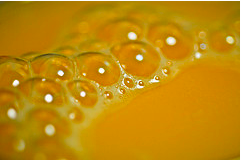Your Morning OJ Is The Result Of A Complicated Algorithm Designed For Maximum Tastiness
Whether you like it pulp-free, full of pulp, sweet or tarty, orange juice is probably the most popular breakfast beverage around, especially when it’s freshly-squeezed. Pressed for time, many consumers opt for “fresh” offerings like Coca-Cola’s Simply Juice orange juice. But despite that moniker, it turns out the stuff is anything but simple. Instead, the company employs a baffling array of complicated mathematical calculations, satellite imagery and an all-knowing algorithm.
Our minds were fairly boggled while digging into BusinessWeek‘s behind-the-scenes glimpse at Coca-Cola’s orange juice operations. Because Mother Nature isn’t inclined to churn out orange groves full of the exact right fruits for juicing, the ones that will result in a consistent product year-round, Coca-Cola has found a workaround to get nature to work to its advantage.
“You take Mother Nature and standardize it,” says the director of procurement at Coke’s juice packaging plant in Auburndale, Fla. “Mother Nature doesn’t like to be standardized.”
At the heart of the process is a methodology called Black Book, which was developed to account for weather, regional consumer preferences and other factors to make sure you can get the same orange juice at the store even when peak growing season is over. The company’s vice president of business acceleration calls the algorithm “a flight simulator” for its juice business.
The whole process is serious business — thee same revenue analytics consultant responsible for Black Book also developed a model for Delta Air Lines to maximize the airline’s revenue per mile flown.
He says making orange juice “is definitely one of the most complex applications of business analytics. It requires analyzing up to 1 quintillion decision variables to consistently deliver the optimal blend, despite the whims of Mother Nature.”
For example, the Black Book algorithm takes into account the more than 600 flavors in an orange, combines those with consumer preferences and matches that data to a profile detailing acidity, sweetness, and other attributes of each batch of raw juice. Then it spits out instructions to Coke on how to blend its batches perfectly.
Black Book also factors in things like weather patterns, expected crop yields, and cost pressures so that Coke can plan far ahead and not be bound by the three-month peak rowing season. If there’s an unexpected natural disaster, Coke will be prepared and juice will still be made.
Also involved in this involved process are satellite images used by one of Coke’s partners, Cutrale, the company responsible for providing the fruit that goes into the juice. Cutrale keeps an eye on crops in Brazil using satellite imaging to make sure the oranges are grown how Cokes wants them to. Super science-y!
While the Coke juice plant has tanks holding juice for up to 8 months, the juice you sip during the peak growing months between April and June could go from grove to glass in as little as 24 hours. But because some of those engineered juice batches in other months involve oranges from different groves, critics say companies like Coke should alert consumers how much processing is actually involved in “fresh” juice.
Just think about that exhaustive process next time you take a sip of juice. Makes squeezing your own seem a lot less daunting, and hey, no tricky math involved!
Coke Engineers Its Orange Juice—With an Algorithm [Businessweek]
Want more consumer news? Visit our parent organization, Consumer Reports, for the latest on scams, recalls, and other consumer issues.


